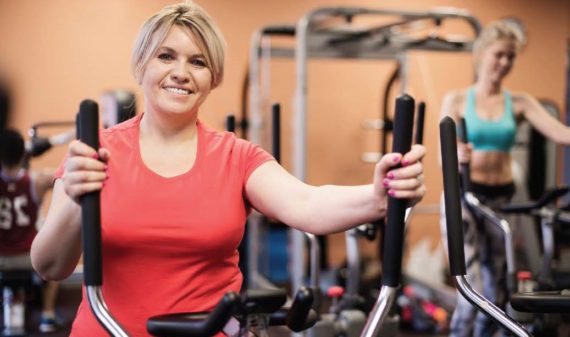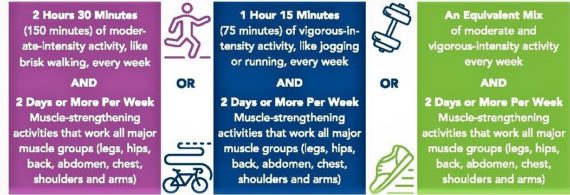
Choosing what you eat and do each day are examples of your behaviors. They include nearly every decision you make and can greatly impact your health. Do you grab a quick bite from a fast food restaurant or pack a healthy lunch? Do you make time to exercise? Are your behaviors influencing your family’s behaviors too? This section discusses easy ways you can make healthy lifestyle choices. Changing behaviors that may have contributed to weight gain is one way to improve your weight and health — either alone or with other obesity treatment options.
Healthy lifestyle options include:
- Self-monitoring
- Physical activity
- Support groups
Understanding Health and Nutrition
Most people do not spend time thinking about the complex systems that make up our bodies. We may not take the time to think about how the food we eat and the physical activity we do can either help or harm our body depending on our choices. Learning more about your body and how to properly nourish it are essential for improved health and weight. There are a variety of ways to learn more, including:
Talking to Your Health Care Provider (HCP) – Discussing your weight with your HCP is a great first step. It is important to be prepared for this visit; here is a list of things to bring for your discussion:
- A food journal that shows all foods and beverages you consumed for one week.
- A list of any and all physical activity for that same period of time.
- A list of any and all medical conditions you have as well as ones in your family history, including type 2 diabetes, heart disease, etc.
- A list of all prescription medications, over-the-counter medications, vitamins and supplements you take on a regular basis. (Your pharmacy can print a list of the prescription medications you take, but you will likely need to add the other unless the pharmacy knows about the well.)
Meeting with a Registered Dietitian (RD) – Registered Dietitians are a wonderful resource for anyone wanting to learn about eating for weight loss and improved health. It is hard to truly know how much of which foods are healthy for our bodies, but an RD can help you with:
- Making meal plans that work for you.
- Learning about food and how they affect your weight and health.
- Developing nutritional goals.
Self-monitoring
Losing weight is not necessarily as simple as eating less and moving more. There is also no one-size-fits-all approach to weight-loss. Self-monitoring is an easy and effective way to keep track of what food and beverages you consume, how much you exercise and more. Your goal in monitoring your lifestyle should be to increase self-awareness of your choices and make modifications where necessary.
Some commonly used self-monitoring tools include:
- Food journals
- Regular self-weighing
- Activity trackers or apps
- Wearable wrist-bands and smartwatches
Each of these tools can be used to track your daily activities and lifestyle choices. Tracking them can help you see a pattern in your choices. You can use these patterns to find which ones can lead to weight gain and which ones can lead to weight-loss. No matter how you choose to track your lifestyle choices; self-monitoring is a crucial tool in weight-loss, weight management and long-term healthy living.
Physical Activity
Before you begin any new physical activity plan, be sure to check with your healthcare provider. Physical activity is a key part of any health and wellness plan. Combining physical activity with healthier eating is an important step in beginning to reach and/or maintain your goals. Increasing your physical activity will help you feel better and give you more energy. Physical activity can not only help you manage your weight, but it may also contribute to healthy bones and make you feel good.
According to the Centers for Disease Control and Prevention (CDC), adults ages 18-64 should get the following amount of physical activity each week:

Start by Developing Your Exercise Goals
Developing fitness goals is an important step in beginning or changing your physical activity habits. Saying you are going to walk more is a great idea, but if a goal is that vague, it will be easier to come up with excuses not to walk and you might wonder if you really have been walking more. Developing SMART goals that follow the FITT principle can help you be successful on your weight-loss journey.
Specific: Pick one specific behavior to modify per goal.
Measurable: Can you measure this goal against a baseline?
Attainable: Is this goal attainable? Use action words when writing goals. For example: “I can take a walk each night after dinner,” or “I will drink one less can of soda each day.”
Realistic: Do you have realistic and honest expectations of yourself with your time, body and likes/dislikes?
Timely: Is your timeline for modifications reasonable and manageable?
Frequency: How often will you exercise?
Intensity: How hard will you exercise?
Type: What kind of exercise will you do?
Time: how long will you exercise?
SMART Goals that follow the FITT Principle are clearly defined and allow you to easily know if you are keeping to your plan.
Measuring Your Exercise Intensity
Exercise is measured by a term called Rate of Perceived Exertion (RPE). RPE is a physical activity scale of one to 10, where one is the easiest (like lying in bed) and 10 is the hardest (like sprinting as fast as you can). You should aim to have physical activity at a rate around six or seven.
If you are walking with someone, keeping a level six or seven pace would be one where you can have a conversation, but will need to take regular, deep breaths. If you are exercising above that level, it will be very hard or impossible to carry on a conversation at the same time.
Low Intensity
This is an activity level you can continue for a longer period of time, such as shopping, a casual walking pace or housework.
Moderate Intensity
This level of activity will get your heart rate up and it will take effort to maintain the intensity. This level will help you maintain your health.
Vigorous Intensity
This level of activity will feel like an all-out effort. Your heart rate will be high and you will not be able to speak complete sentences without taking several breaths. This level of intensity improves athletic conditioning.
Exercise can come in many forms and does not always have to mean spending hours in the gym. Here are some great examples of simple exercises that you can do alone or with a partner:
- Brisk walking (15-minute mile pace)
- Yard or housework
- Leisurely bike ride
- Playing with family
- Light swimming
Rember these few things about exercise:
- Make it simple.
- Make it Happen.
- Make it realistic.
- Most importantly, make it fun!
The most important commitment YOU can make is to YOUR weight and health!
Support Groups
The journey of improving your health and weight can sometimes feel like a difficult and lonely one. Finding the right weight-loss plan can take time and be mixed with setbacks.
However, you are not alone. Support groups are a wonderful resource for you and others to share and learn with each other. Support groups can be women-only, men-only, faith-based, offered by your local community center or available online. Finding a support group does not have to be difficult. Here are some ideas for finding and engaging in one near you:
- Ask your healthcare provider for a support group reference.
- Do not be afraid to speak up and share your story. There is a good chance someone else in the room is thinking or feeling or going through the same thing.
- If you feel uncomfortable meeting face to face, consider a web-based support group.
Setting Realistic Goals:
When developing your goals for weight-loss, exercise, eating healthy and more, it is important to keep them realistic. Quite often, individuals become frustrated when they do not see immediate weight-loss results. It is important to not let yourself become frustrated with your weight-loss plan. Changing your diet, incorporating exercise and more can all be significant life changes and they need to be taken seriously. Here are a few tips for developing realistic goals:
- Average weight-loss is one to two pounds per week
- Start slow with exercise and find an activity you enjoy.
- Ask your spouse, family member or friend to exercise with you.
- Make meal times a family affair. Have your children help with cooking and let them choose healthy foods as well.
- Recognize your progress. Continue a proactive mindset and remember that each day is another day forward.
- Don’t be afraid to ask for help. Feel like you might be slipping with your eating or exercise routine? Talk to a family member, friend or healthcare professional and they’ll help you get back on track.
Conclusion
Your everyday choices are your behaviors. They include everything from how much sleep you get each night to what you have for lunch and if you take the stairs or the elevator. Your behaviors join together to form your lifestyle. Making lifestyle modifications is key for managing your health. Finding modifications that work and are ones you can keep long term can be the hardest to make, but they also give you the greatest results on your weight-loss journey.
